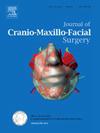BSSRO后两期下颌对称改善:60例连续不对称前凸患者的CBCT分析。
IF 2.1
2区 医学
Q2 DENTISTRY, ORAL SURGERY & MEDICINE
引用次数: 0
摘要
双侧矢状裂支截骨术后不对称前突下颌骨的重塑过程尚不完全清楚。本研究探讨了BSSRO术后下颌对称性的顺序变化。回顾性分析2018年1月至2023年12月连续60例接受BSSRO治疗的不对称前凸患者。在术前(T0,术前2周内)、术后即刻(T1,术后2天内)和术后长期(T2,术后至少6个月后)三个不同时间点进行CBCT扫描。使用均方根误差(RMSE)量化下颌对称性,该误差来源于右偏下颌骨与镜像下颌骨之间的空间差异。此外,采用配对t检验评估12个地标点的位置差异和6个下颌节段的体积差异。在T0时,平均RMSE为2.729,在BSSRO后立即显着下降到2.163 (p本文章由计算机程序翻译,如有差异,请以英文原文为准。
Two-stage mandibular symmetry improvement after BSSRO: A CBCT analysis of 60 consecutive patients with asymmetric prognathism
The remodeling process of asymmetrically prognathic mandibles following bilateral sagittal split ramus osteotomy (BSSRO) remains incompletely understood. This study investigates the sequential changes in mandibular symmetry after BSSRO. A retrospective analysis was conducted on 60 consecutive patients with asymmetric prognathism who underwent BSSRO between January 2018 to December 2023. CBCT scans were obtained at three different time points: preoperatively (T0, within 2 weeks before surgery), immediately postoperatively (T1, within 2 days) and long-term postoperatively (T2, at least 6 months later). Mandibular symmetry was quantified using root mean square error (RMSE), derived from spatial discrepancies between the right-deviated mandibles and its mirrored counterpart. Additionally, positional discrepancies of 12 landmark points and volumetric differences of 6 mandibular segments were assessed using paired t-test. At T0, the mean RMSE was 2.729, which significantly decreased to 2.163 immediately after BSSRO (p < 0.0001), and further to 1.916 at T2 (p < 0.001). During T0-T1, significant corrections were observed in X-directional discrepancies in CoG-C, MF and CoG-B. However, BSSRO increased Y-directional discrepancies in Go and Cd, as well as Z-directional discrepancies in CoG-R, while volumetric asymmetry expanded in three mandibular segments (C: p = 0.002; B: p = 0.003; R: p < 0.001). During T1-T2, significant reductions occurred in X- and Z-directional discrepancies of Go and Z-directional discrepancies of CoG-R, with resolution of volumetric asymmetry in the mandibular body (p = 0.001) and ramus (p < 0.001). Mandibular symmetry improvement after BSSRO occurs in two distinct stages. The first stage is primarily due to surgical repositioning of the deviated distal segment, while the second stage involves orthodontic treatment and bony remodeling of the morphologically asymmetric proximal segments.
求助全文
通过发布文献求助,成功后即可免费获取论文全文。
去求助
来源期刊
CiteScore
5.20
自引率
22.60%
发文量
117
审稿时长
70 days
期刊介绍:
The Journal of Cranio-Maxillofacial Surgery publishes articles covering all aspects of surgery of the head, face and jaw. Specific topics covered recently have included:
• Distraction osteogenesis
• Synthetic bone substitutes
• Fibroblast growth factors
• Fetal wound healing
• Skull base surgery
• Computer-assisted surgery
• Vascularized bone grafts

 求助内容:
求助内容: 应助结果提醒方式:
应助结果提醒方式:


